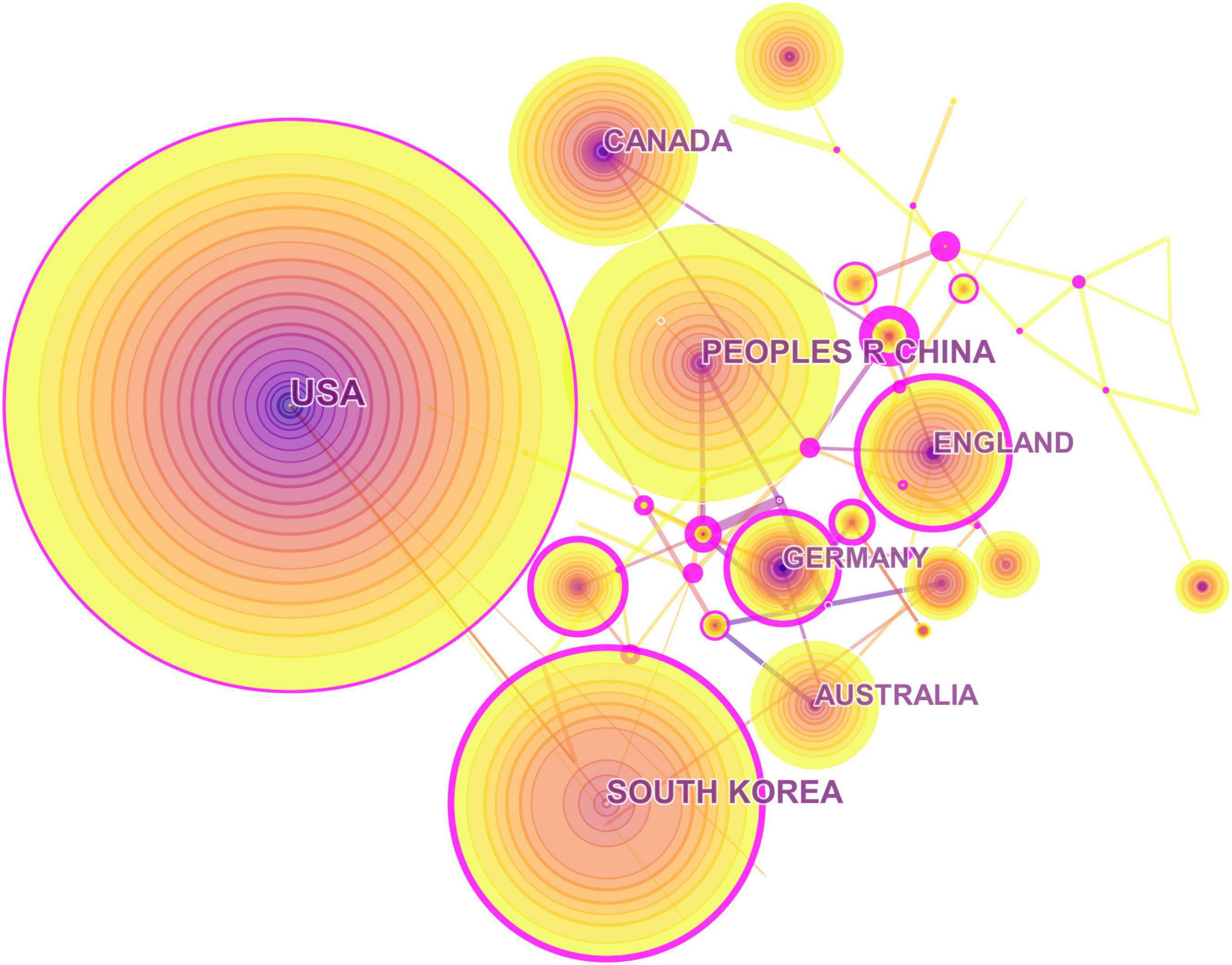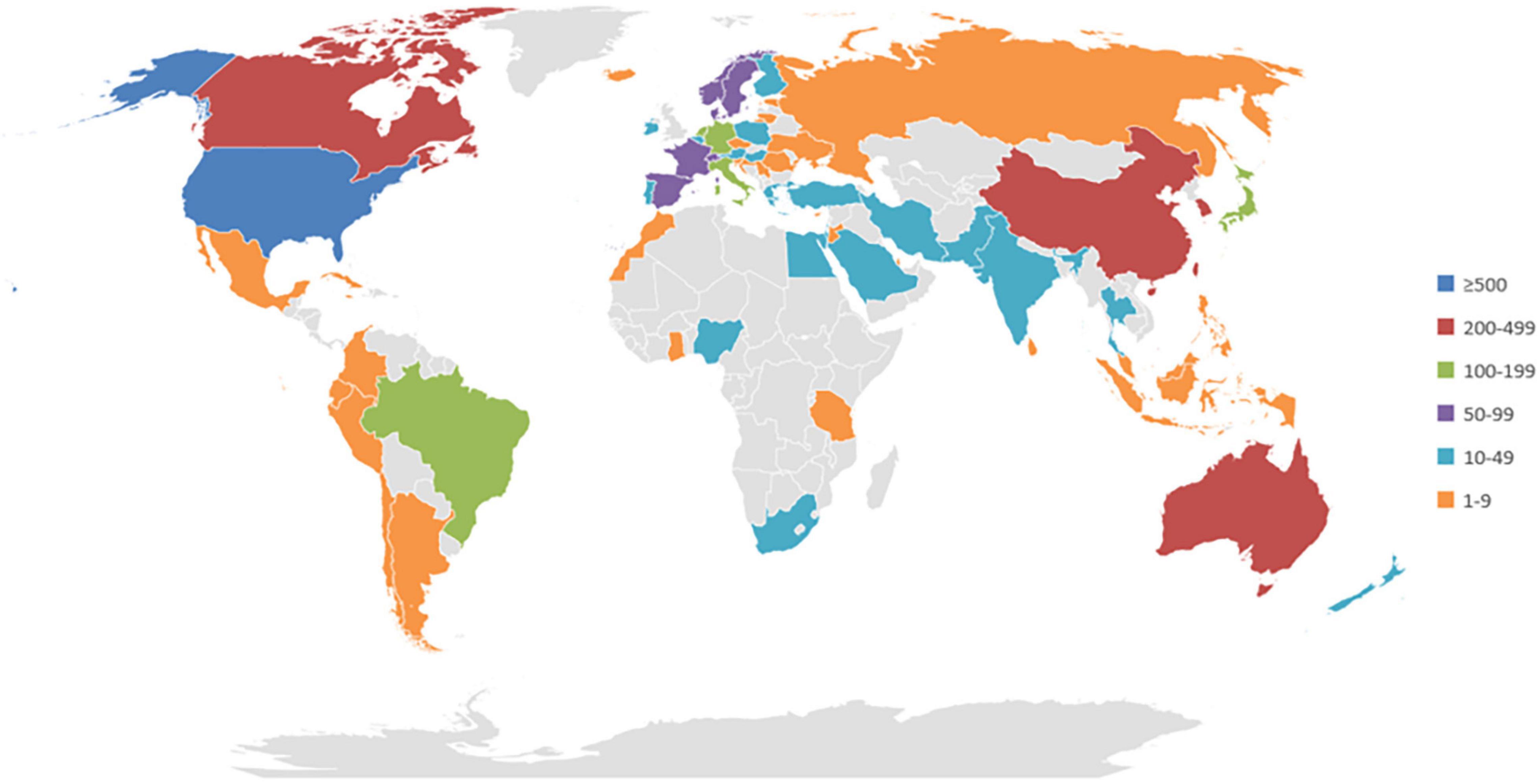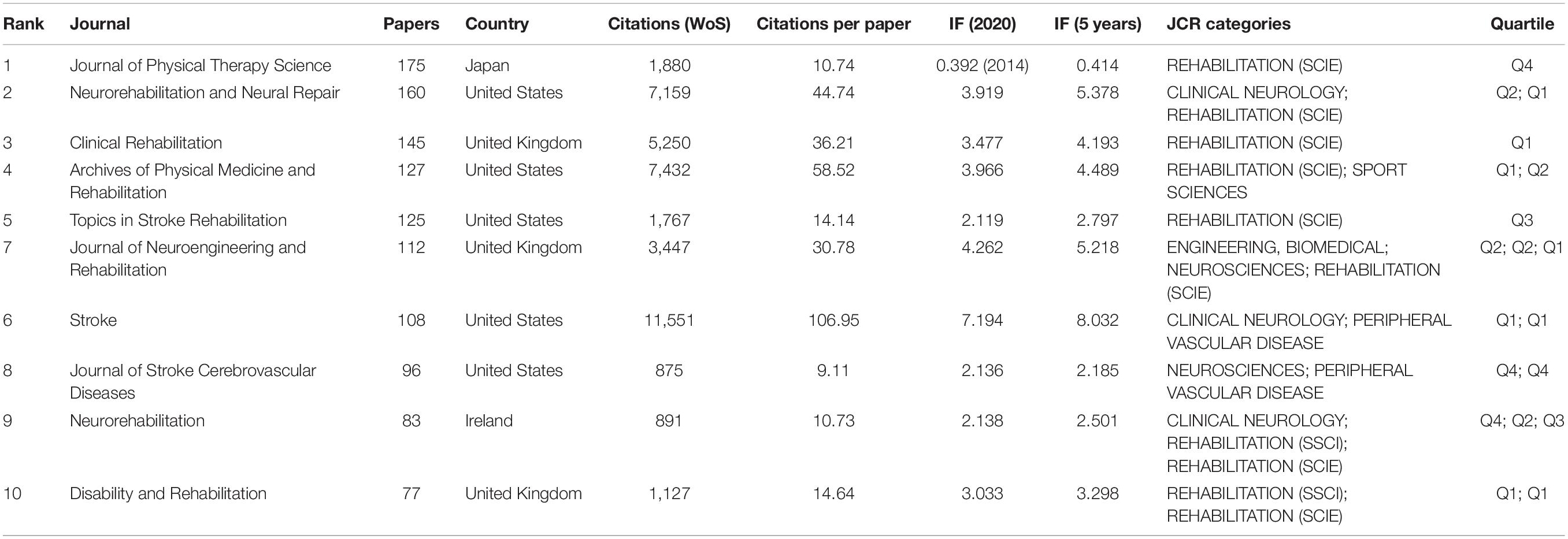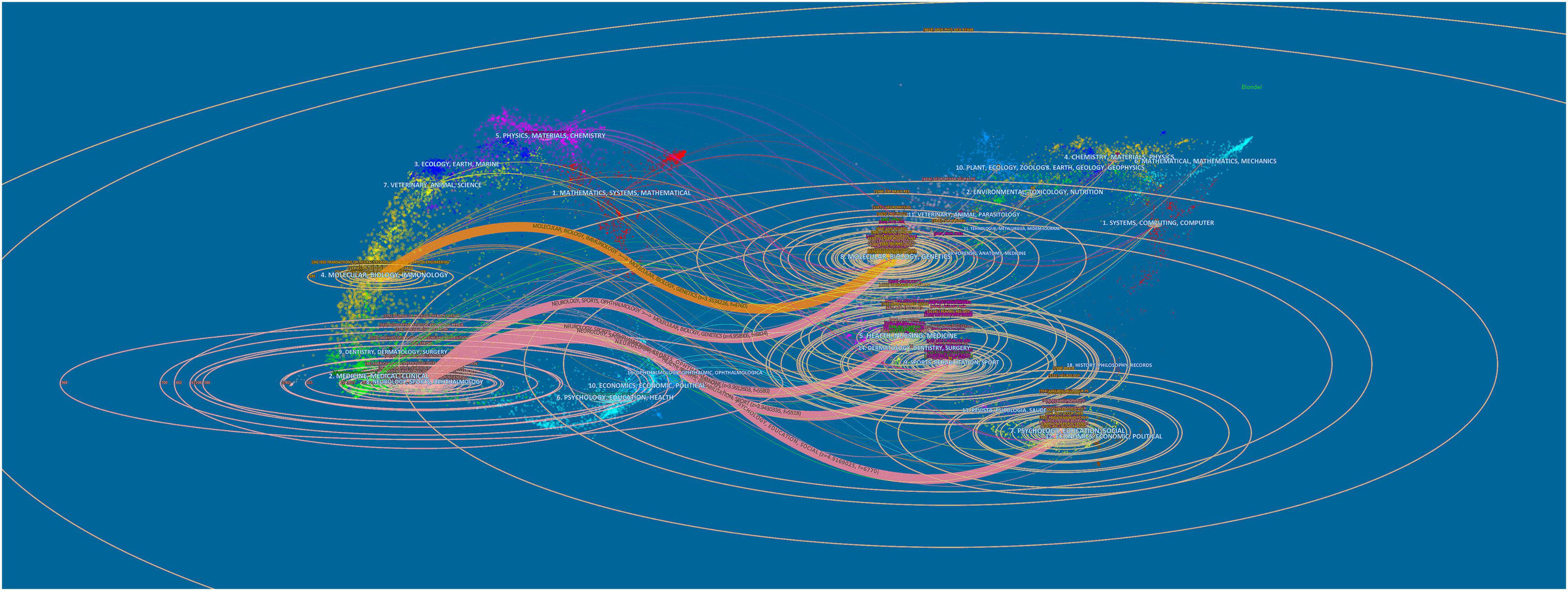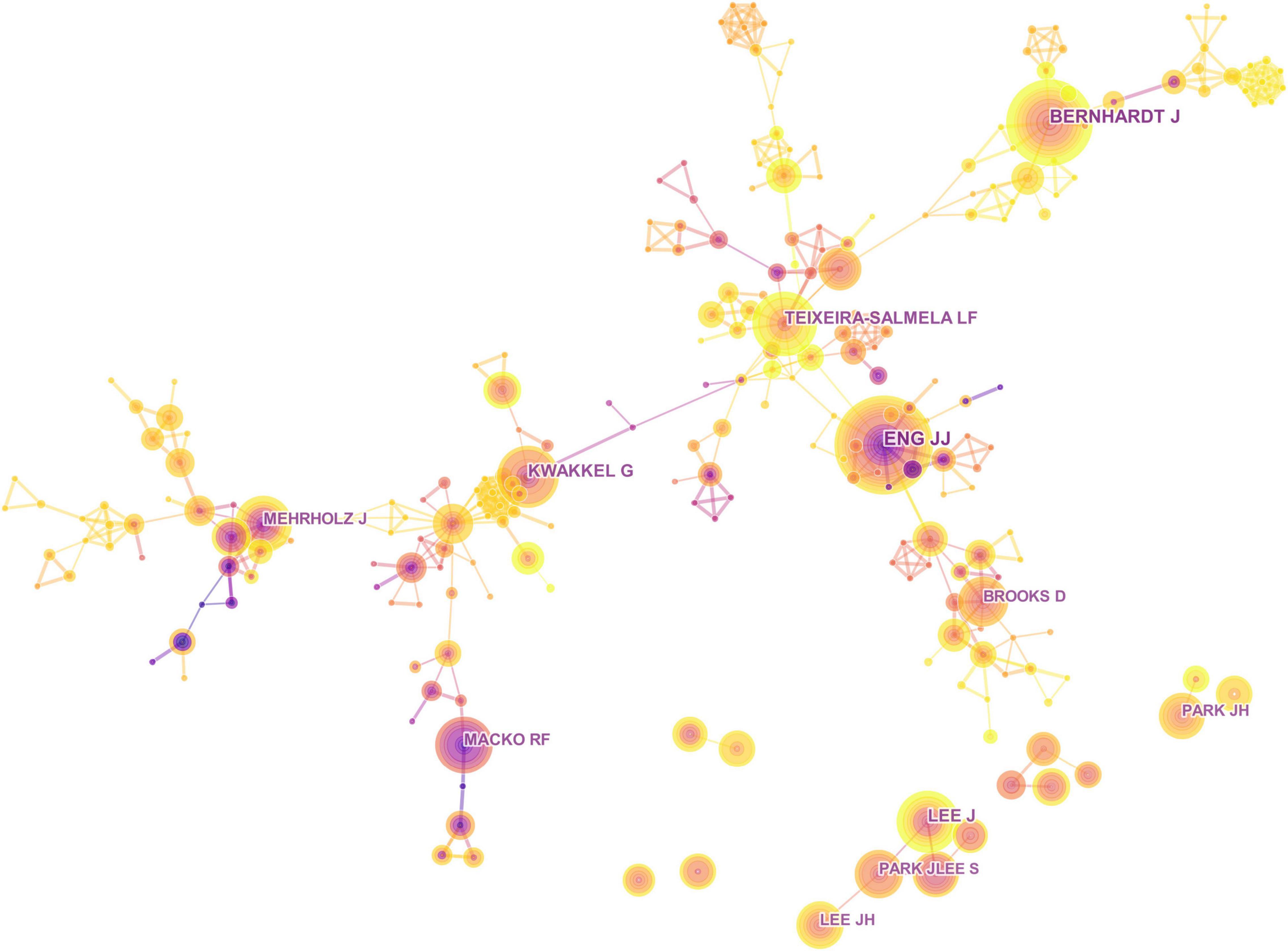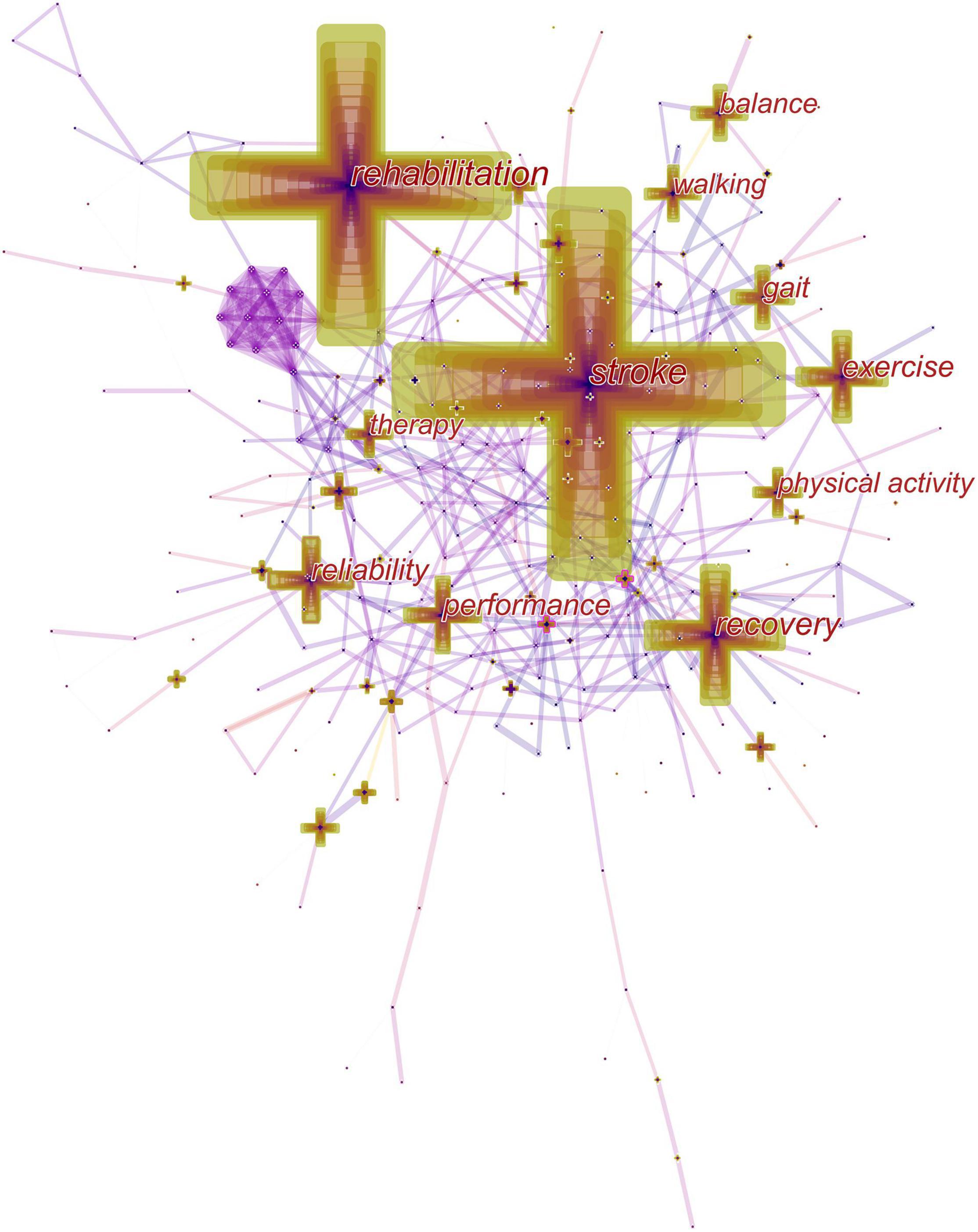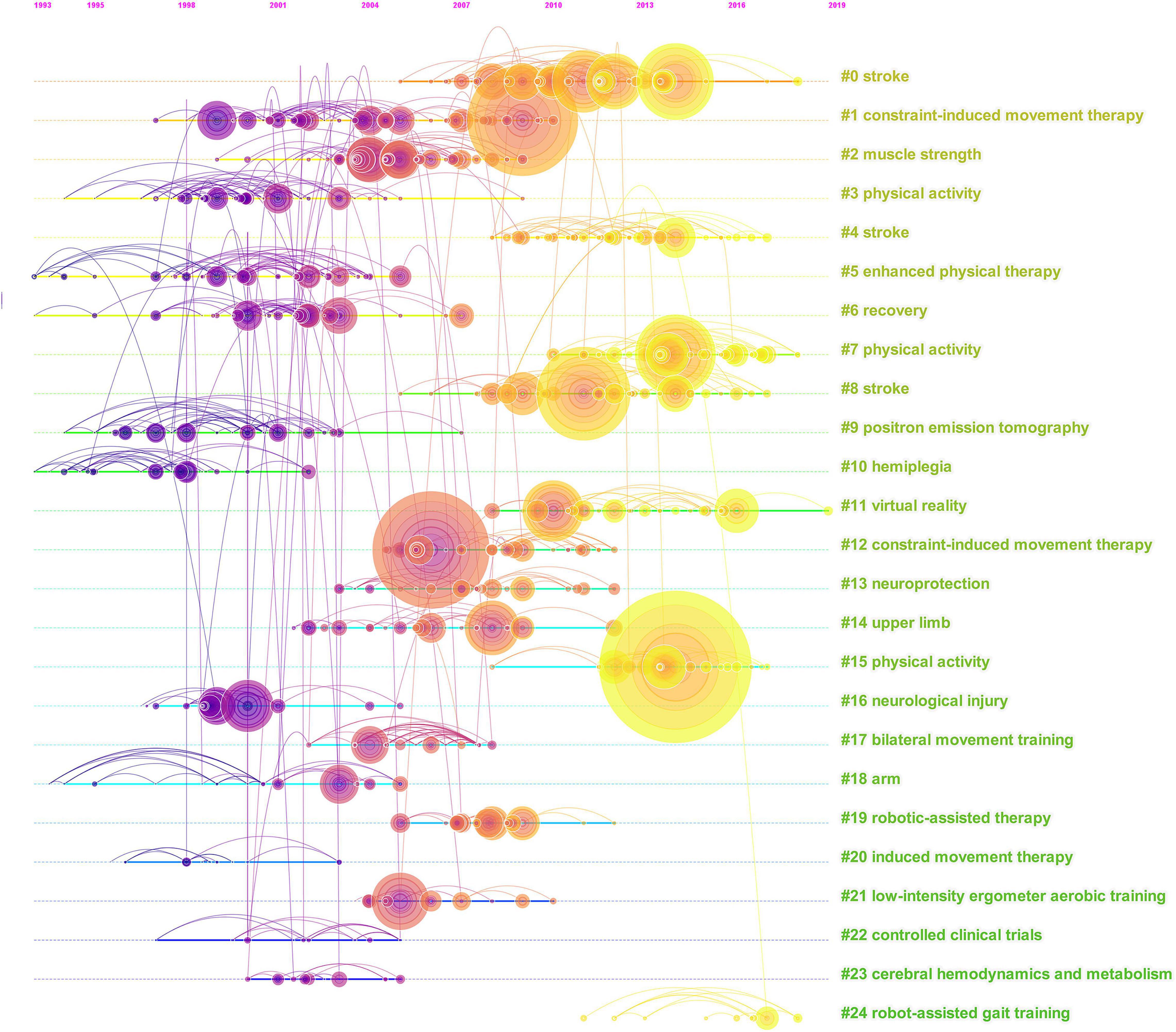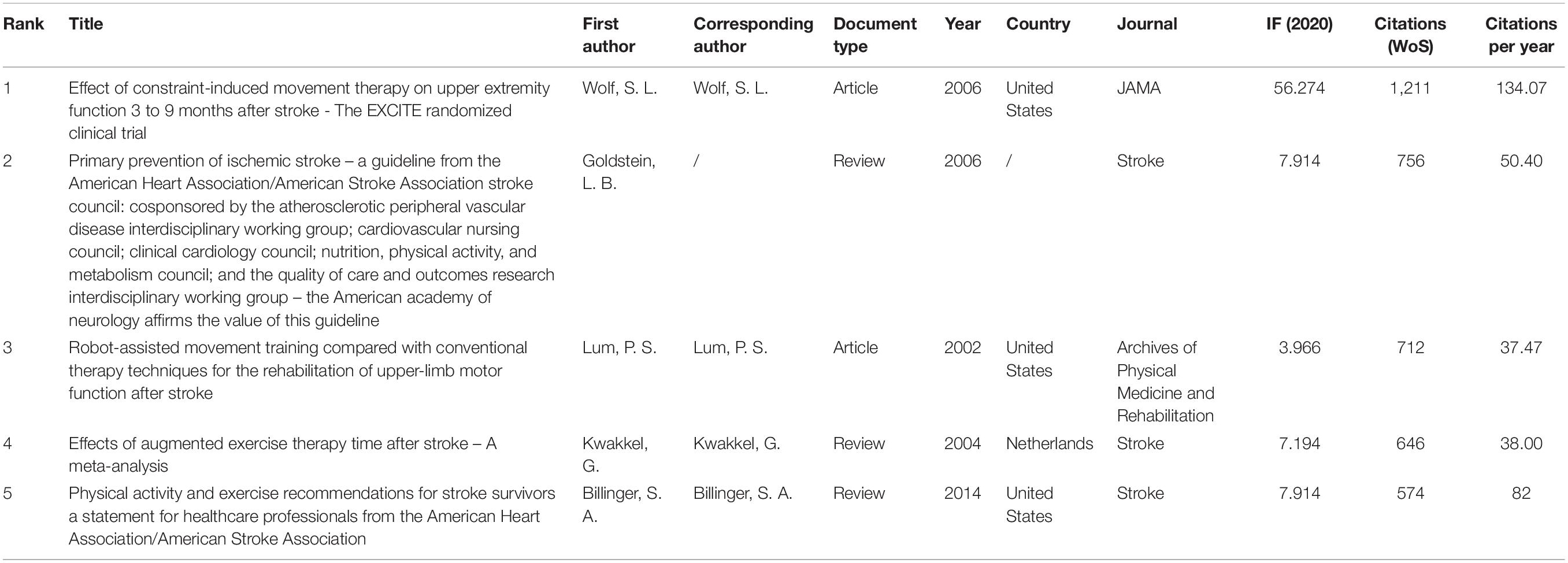- 1Department of Treatment, The Second Rehabilitation Hospital of Shanghai, Shanghai, China
- 2Department of Sport Rehabilitation, Shanghai University of Sport, Shanghai, China
- 3Department of Rehabilitation Medicine, Shanghai Shangti Orthopaedic Hospital, Shanghai, China
Objective: To make a bibliometric analysis of global trends in research into exercise interventions for stroke between 2001 and 2021.
Method: This study did the systematic literature from 2001 to 2021 in Web of Science Core Collection. CiteSpace software was used to analyze the relationship of publications with countries, journals, authors, references, and keywords.
Results: A total of 3,484 publications were obtained in the bibliometric analysis. The number of publications increased gradually over the period. The United States have the most number of publications. The journal stroke had the most citations per paper (106.95) and the highest impact factor (IF 2020, 7.194). The most high frequency keywords are “stroke,” “rehabilitation,” and “recovery,” the top of burst key words are “health,” “speed,” and “aerobic exercise”.
Conclusion: These findings provide the trends of exercise for stroke s and provided the potential research frontiers in the past 20 years. It will be a useful basis for further research into focus issues, cooperators, development trends.
Introduction
Stroke is a kind of cerebrovascular diseases, and its main clinical manifestations are cerebral ischemia and hemorrhagic injury. In 2017, there were about 104.2 million stroke survivors and 11.9 million new cases of stroke worldwide (Gbd 2017 Disease and Injury Incidence and Prevalence Collaborators, 2018). On a global scale, stroke is the second leading cause of death and the third leading cause of disability (Johnson et al., 2016). The prevalence of stroke and mental illnesses is estimated to result in continued economic cost worth $240.67 billion by 2030 (Ovbiagele et al., 2013). Stroke not only affects the long-term functional disability but also increases the economic burden on families and the healthcare system (Prince et al., 2015). Therefore, low-cost and easily accessible treatments with minimal side effects must be developed to address stroke.
According to the American Heart Association/American Stroke Association, exercise therapy is beneficial to stroke survivors (Ovbiagele et al., 2013). Many studies have reported that gait-oriented training, aerobic treadmill training, intensive mobility training, and physiotherapeutic interventions, can improve disability for stroke survivors (Hesse et al., 2003; Eng and Tang, 2007; van de Port et al., 2007; Hesse, 2008; De Rooij et al., 2016). Several meta-analyses focus on specific exercise therapy for stroke, such as Tai Chi exercise (Wu et al., 2018), aerobic exercise (Wang et al., 2019), sling exercise (Chen et al., 2016), and traditional Chinese exercise (Chen et al., 2015). Various exercise therapies are used to treat stroke, but there is no clear evidence to support the superiority of any particular exercise intervention. Also, there are lack of systematic analysis of global research into exercise for stroke. Therefore, there is a need to summarize the progress of research into exercise therapy for stroke over recent decades, and to provide objective data on which to base future research.
Bibliometric analysis has been considered as a quantitative statistical tool to describe the knowledge structure and keyword trends in specific research areas (Hicks et al., 2015). This type of study could offer readers the general aspects of research topic on distribution by country, institution, author, and journal. Bibliometric methods have been used in many research fields, including stroke (Feng et al., 2013) and exercise (Fares et al., 2017; Khatra et al., 2021). From the perspective of research progress, the number of clinical trials and papers on stroke rehabilitation has increased in the past years (Feng et al., 2013). Exercise as a therapeutic intervention in the treatment, rehabilitation, and prevention of illness (McCrory, 2006). However, no detailed bibliometric analysis has been conducted on the topic of exercise for stroke.
To address the shortage of quantitative analysis of exercise for stroke research, the present study aims to obtain the global scientific outputs of the research using exercise from 2001 to 2021 and quantitative information about the distribution of countries, institutions, journals, authors and visual information. This study will allow researchers to understand the hotspots and emerging trends of research on exercise and stroke.
Methods
Search Strategy and Data Acquisition
Web of Science (WoS) contains 20,000 high-quality and influential academic journals related to 250 disciplines around the world. The database with comprehensive citation index records is conductive to data mining and co-citation analysis (Waqas et al., 2020). It is the authoritative data source for data extraction in bibliometric analysis, and has been used in many previous studies (Chen et al., 2012; Ellegaard and Wallin, 2015; Yan et al., 2020). It also had more accurate document type labeling than PubMed, Scopus (Yeung, 2019).
Publications on stroke and exercise research from 2001 to 2021 were retrieved and downloaded from the Science Citation Index Expanded (SCI-E) of WoS Core Collection (WoSCC). The search strategy was as follows: TI = (stroke OR apoplexy OR cerebrovascular accident OR cerebral hemorrhage OR hematencephalon OR encephalorrhagia OR cerebral ischemia) AND TI = (exercise OR train OR physical activity OR sport OR movement OR motion), language = English, and document type = article or review. A total of 3,484 publications were retrieved on 1 January 2022.
Knowledge Visualization Analysis
Publication records, including countries or regions, journals, authors, keywords, references, citations, citations per year, H-index, and impact factor (IF), were extracted from WoSCC. The H-index is a numerical indicator that evaluates the impact of scholars’ or journals’ publications and performance (Hirsch, 2005). IF reflects the average number of citations of a paper published in a journal and assesses the relative importance of the journal (Sharma et al., 2014). CiteSpace V was used in building knowledge network and citation paths (Chen et al., 2019). The publication records from WoSCC were input into CiteSpace, which generated collaborative networks (countries and authors), co-occurrence networks (keywords), and co-citation networks (references). The node represents the subject analyzed. Larger nodes denote greater number of occurrences or citations. A centrality index greater than 0 will be marked with a purple ring around the node, representing landmark works or theories (Waqas et al., 2020). Burst keywords or references indicates that the subjects frequently appear or are cited over a period, and represents those relevant topics have attracted considerable attention from researchers. Thus, they can be regarded as a research hotspot or research frontiers (Chen, 2006). Important themes, recent developments, and emerging trends in the field can be detected effectively based on these cues. The relationship between the publication outputs and IF was analyzed by Pearson correlation analysis in IBM SPSS Statistics 26. Statistical significance was considered at P < 0.05.
Results
Publication Activity
Web of Science Core Collection yielded 3484 publications during the period of 2001–2021, with a total H-index of 125 and citations of 90,348 by citing 39,995 papers. Each paper was cited 25.93 times on average. In general, annual papers and citations presented a growing trend. The average number of citations per paper in WoSCC was 0.34 in 2001 and 28.88 in 2021. The vast majority of these papers were articles. In 2021, the number of articles was 343 and received 9,248 cumulative citations, about 9.03 and 5.27 times more than reviews, respectively (Figure 1).
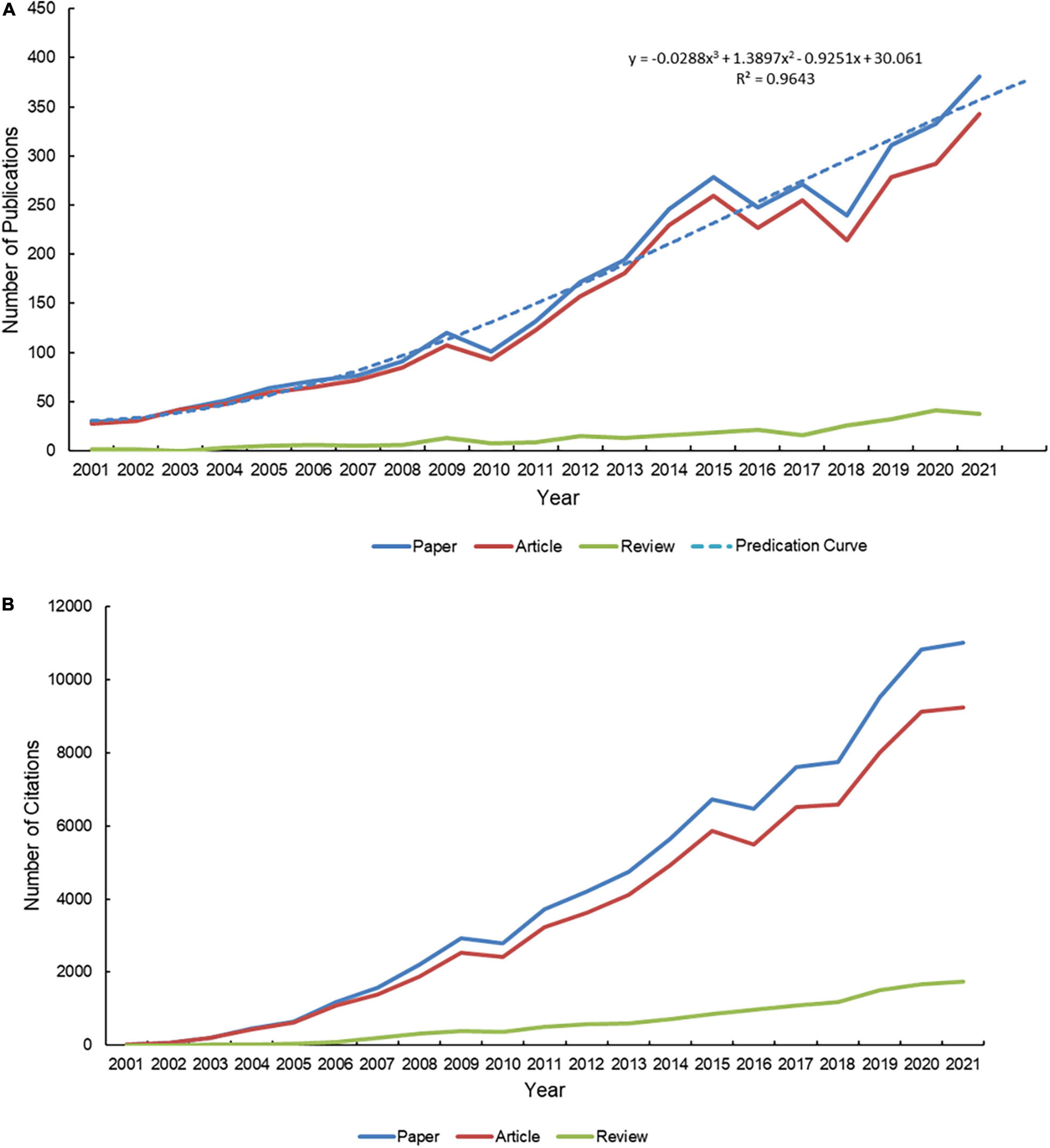
Figure 1. Trends of publications and citations. (A) Trends of publication outputs and growth prediction from 2001 to 2021. (B) Trends of citations received by publications from 2001 to 2021.
Regional Trends
In accordance with the address of authors, 81 countries or regions contributed to these publications. The regions with the highest output of publications were in the United States, South Korea, China, Canada, and United Kingdom. Amongst the top 10 publication outputs, only China was a developing country, and others were developed countries. Switzerland, Austria, Singapore, Denmark, and Saudi Arabia were the top five countries and had a significant influence on global cooperation. These central nations are mainly developed countries, and they have also formed cooperative relations with several developing countries. In terms of publication output, none of the top five countries were considered important in the collaboration network (Figures 2, 3).
Journal Characteristics
The papers were published in 584 academic journals. In the top 10 journals for publication output, Journal of Physical Therapy Science had the highest number of papers (175 publications), whereas Disability and Rehabilitation had the lowest number of papers (77 publications). Half of the journals were established in the United States, and all journals were based in developed countries. Stroke had the highest number of citations, citations per paper (106.95) and IF (2020, 7.194), occupying an important position in this field. The IF of these journals mainly concentrated in the range from 2 to 4, revealing that relevant papers published in high-IF journals present great challenges. Pearson correlation analysis revealed that publication outputs and IF had no significant correlation (r = −0.198, p = 0.584). In Journal Citation Reports, the majority of the top 10 journals belonged to the Rehabilitation category and were in Q1 (Table 1).
Figure 4 shows a dual-map overlay of all academic journals, mapping the citation paths of subject fields. The labels on the left of the dual-map represent the discipline covered by the citing journals, whereas those on the right indicate the discipline of the cited journals. Most journals were from neurology, sports, ophthalmology, medicine, medical, and clinical field, called research frontier. Cited papers were mainly published in molecular, biology, genetics, health, nursing, medicine, sports, rehabilitation, psychology, education, and social journals, called knowledge base.
Author Analysis
A total of 12,130 authors published these papers. Figure 5 shows the collaboration network of authors. Amongst the top prolific authors, Eng J. J. ranked the first (36 publications), followed by Bernhardt J. (34 publications), Kwakkel G. (29 publications) and Teixeira-Salmela L. F. (29 publications). Eng J. J. was based at the University of British Columbia. He led their research team to design the Graded Repetitive Arm Supplementary Program that helped improve the recovery of stroke survivors’ arm function and conducted a study on the use of robotic exoskeleton for walking training early after stoke. However, the link between nodes was sparse, and the centrality for cooperation was 0, indicating that the cooperation between various authors in this field was not very sufficient.
Keyword Co-occurrence
Keywords with high frequency of occurrence and high value of centrality reveal the research hotspots in the past 20 years, and those with strong citation bursts can predict future research frontiers. By the end of 2021, “stroke,” “rehabilitation” and “recovery” were the top three high-frequency keywords. In terms of centrality, “brain” ranked the first, followed by “activation” and “mechanism” (Figure 6). The top 40 keywords obtained based on the times of occurrence and centrality were divided into eight themes (diseases, treatment, body region, outcome, evaluation, population, research design, and mechanism) (Table 2). Amongst the burst keywords, “health,” “aerobic exercise,” “speed,” “motor,” “stroke rehabilitation,” “mobility,” “health care professional,” “impact,” “risk,” and “mortality” were cited frequently until 2021 (Figure 7).
Reference Co-citation
A timeline map of co-citation references with 19 clusters is shown in Figure 8. Each cluster was composed of papers with similar topics, named by nominal terms extracted from keywords in these co-cited papers. Cluster #0 (plasticity) was the largest, followed by cluster #1 (rct-rehabilitation-stroke interventions-upper extremity-motor recovery-behavior) and cluster #2 (sensorimotor impairments). Cluster #18 (movement training) appeared the earliest. Cluster #3 (physical activity) gradually attracted people’s attention in recent years. The most cited reference (physical activity and exercise recommendations for stroke survivors: a statement for healthcare professionals from the American Heart Association/American Stroke Association) belonged to cluster #3 (physical activity) (Table 3).
Landmark Publication
Table 4 demonstrates the top five publications with the highest citation frequency. The paper by Wolf et al. (Effect of constraint-induced movement therapy on upper extremity function 3 to 9 months after stroke: The EXCITE randomized clinical trial) was the most cited. It was published in JAMA and had relatively high average annual citations and the highest IF. The top two papers in Table 4 were also the top two references in Table 3. A majority of papers had the same first author and corresponding author and were published before 2010.
In summary, the number of publications related to this research keeps increasing every year. Different countries have shown different international influences in this research field. The results also revealed some core journals and potential collaborators. The analysis of keywords and references indicated research status and hot spots, as well as emerging trends.
Discussion
Global Trends of Exercise for Stroke Research
To our knowledge, this is the first bibliometric analysis of exercise for stroke based on WoSCC. We used the CiteSpace tool to obtain 3,484 published papers and show the continuous scholarly work in this field of exercise for stroke between 2001 and 2021. The results show that the number of publications increased gradually annually. The rapid growth of publications does not indicate that these papers have high quality; it only indicates that many researchers pay more attention to exercise for stroke. The top 10 journals did not have high IF. The journals with extremely high IF, such as Lancet, Nature did not publish the topic articles. Maybe, we think that this field has some innovative and breakthrough discoveries. According to the results, the United States has a positive sense of collaboration and plays an important role in the field of exercise for the research. There was strong positive correlation between the GDP of countries and stroke publication output (Salhab et al., 2018). We think that the strong economic foundation and larger number of stroke survivors have endowed the United States with important role in the research.
Research Focuses on the Exercise for Stroke Research
According to the co-occurrence network of keywords, the keywords with the highest frequency are “stroke,” “rehabilitation,” and “recovery”; that is to say, how to recover or rehabilitate the patients with stroke is still a hot topic in the field of exercise for stroke. Figure 7 shows that the burst keywords were detected by CiteSpace V. According to these data, we could know the frontiers of exercises for the research. The top burst keywords are “health,” “aerobic exercise,” and “speed,” indicating potentially emerging trends. The three research trends are as follows:
1. Health: there are different kinds of interventions for different health problems in stroke survivors. Physical exercises combined with cognitive training produced greater benefits on cognitive function in survivors with vascular cognitive impairment (Johnson et al., 2018; Bo et al., 2019). Chinese traditional exercises could help reduce symptoms of anxiety and stress and improve the sleep of the patients with stroke (Taylor-Piliae et al., 2021). Stroke was closely related to cardiovascular health; the effect of intensity and duration of exercise on cardiorespiratory fitness in patients with stroke could be a good topic in future research (Langhammer et al., 2014; Johnson et al., 2018; Luo et al., 2020).
2. Aerobic exercise: aerobic exercise not only has a positive effect on mood, quality of life, and aerobic capacity in patients with early stroke, but also changes the metabolomic profiles in patients with chronic stroke (Pang et al., 2013; Gezer et al., 2019). The evidence and mechanism of the effect of aerobic exercise in patients with stroke have been studied. For example, moderate forced exercise could reduce lesion volume and protect perilesional tissue against oxidative damage and inflammation in early-initiated (24–48 h post-stroke) (Austin et al., 2014).
3. Speed: walking speed can predict and influence functional recovery in patients with stroke. For example, walking speed exercise can improve cognitive function in patients with chronic stroke (Kim and Yim, 2017). Aerobic exercise has a positive effect on gait speed in individuals who have had a left-side stroke (Catapani et al., 2021). Walking speed could be used as an evaluation index and exercise protocol for stroke survivors. There is no mechanistic measure to explain the changes in walking speed during neurologic recovery. A multi-modal approach is necessary for stroke rehabilitation (Wonsetler and Bowden, 2017).
According to the top five references based on the number of citations, we can determine the potentially useful references for exploring the knowledge base of research frontiers. The American Heart Association’s Stroke Council’s Scientific Statement Oversight Committee and Manuscript Oversight Committee provided that the management of stroke survivors could benefit from physical activity and exercise prescription in daily life (Billinger et al., 2014). Many kinds of trials showed that a broad range of interventions could help stroke survivors to recover movement and related function, including constraint-induced movement therapy, electromyographic biofeedback, mental practice with motor imagery and robotics (Langhorne et al., 2009). Patents with different kinds of stroke need different exercise therapy. For example, amongst patients who had their first stroke 3–9 months previously, constraint-induced movement therapy could be an effective method to improve paretic arm function (Wolf et al., 2006). Physical therapy poststroke and intensive high repetitive task-oriented and task-specific training can be used for all phases poststroke (Veerbeek et al., 2014). Therefore, we think that the time point of recovery needs to be focused in the future research, and lager clinical trials with sufficient statistical power are needed to be obtained (Langhorne et al., 2011).
Strengths and Limitations
This is the first bibliometric analysis to summarize the progress and trends of exercise for stroke in the past 20 years on the basis of WoS data. To gain integrated and diverse data, our study included 3,484 publications, and these papers were published in 584 academic journals. Furthermore, this bibliometric analysis not only contained publications, journals, citations, collaboration network of authors, countries, and regions; it also included burst keywords, research keywords by theme, co-occurrence network of keywords, and the top five references and papers on the number of citations.
However, this study has some limitations. Firstly, our study did not search other academic databases, such as PubMed, Embase, and Cochrane Library. Secondly, the variety of languages was limited. The study selected English as the inclusion criterion, papers with other languages were excluded. This could result in publication bias. Thirdly, there was no accurate identification and separation of the interconnections amongst authors, regions or countries, even though our study analyzed their collaboration network.
Conclusion
This study analyzed the trends of exercise for stroke and provided the potential research frontiers in the past 20 years, it can prove useful as a basis for developing improved exercise interventions for stroke. The topic of exercise interventions for stroke is becoming more and more popular amongst clinical workers and researchers. This analysis may enable research teams to collaborate in promoting the application of exercise therapy in the clinical management of stroke. Although this study has some limitations, it provides a useful basis for further research into hot topics, research focuses, cooperators, and development trends of exercise for the research.
Author Contributions
XW and JW: research concept and design. LW and YD: collection and assembly of data and writing the manuscript. TS and ZL: data analysis and interpretation. WW, YZ, and RD: critical revision of the manuscript. YH, YM, and JW: final approval of the manuscript. All authors have read and approved the manuscript.
Funding
This work was supported by the Scientific Research Project of Shanghai Health Committee (20194Y0488 and 20194Y0215), Shanghai Key Lab of Human Performance (Shanghai University of Sport) (No. 11DZ2261100), State Physical Culture Administration (QG2018030), Key Construction Projects of Baoshan Health and Family Planning Commission (BSZK-2018-A01), Shanghai Baoshan District Medical Health Project (19-E-56), and Science and Technology Innovation Project of Science and Technology Commission of Baoshan District, Shanghai (19-E-20).
Conflict of Interest
The authors declare that the research was conducted in the absence of any commercial or financial relationships that could be construed as a potential conflict of interest.
Publisher’s Note
All claims expressed in this article are solely those of the authors and do not necessarily represent those of their affiliated organizations, or those of the publisher, the editors and the reviewers. Any product that may be evaluated in this article, or claim that may be made by its manufacturer, is not guaranteed or endorsed by the publisher.
References
Austin, M. W., Ploughman, M., Glynn, L., and Corbett, D. (2014). Aerobic exercise effects on neuroprotection and brain repair following stroke: a systematic review and perspective. Neurosci. Res. 87, 8–15. doi: 10.1016/j.neures.2014.06.007
Billinger, S. A., Arena, R., Bernhardt, J., Eng, J. J., Franklin, B. A., Johnson, C. M., et al. (2014). Physical activity and exercise recommendations for stroke survivors: a statement for healthcare professionals from the American Heart Association/American Stroke Association. Stroke 45, 2532–2553. doi: 10.1161/str.0000000000000022
Bo, W., Lei, M., Tao, S., Jie, L. T., Qian, L., Lin, F. Q., et al. (2019). Effects of combined intervention of physical exercise and cognitive training on cognitive function in stroke survivors with vascular cognitive impairment: a randomized controlled trial. Clin. Rehabil. 33, 54–63. doi: 10.1177/0269215518791007
Catapani, L. B., Dos Santos, T. P., Toffano, G. C., Souza, H. C. D., and de Araujo, J. E. (2021). Aerobic exercise after left-sided stroke improves gait speed and endurance: a prospective cohort study. Am. J. Phys. Med. Rehabil. 100, 576–583. doi: 10.1097/phm.0000000000001596
Chen, B. L., Guo, J. B., Liu, M. S., Li, X., Zou, J., Chen, X., et al. (2015). Effect of traditional chinese exercise on gait and balance for stroke: a systematic review and meta-analysis. PLoS One 10:e0135932. doi: 10.1371/journal.pone.0135932
Chen, C. (2006). CiteSpace II: detecting and visualizing emerging trends and transient patterns in scientific literature. J. Am. Soc. Informat. Sci. Technol. 57, 359–377. doi: 10.1002/asi.20317
Chen, H., Zhao, G., and Xu, N. (2012). “The analysis of research hotspots and fronts of knowledge visualization based on citespace II,” in Proceedings of the 5th International Conference on Hybrid Learning, Vol. 8, eds S. K. S. Cheung, J. Fong, L. F. Kwok, K. Li, and R. Kwan (Berlin: Springer), 57–68. doi: 10.1007/978-3-642-32018-7_6
Chen, L., Chen, J., Peng, Q., Chen, J., Zou, Y., and Liu, G. (2016). Effect of sling exercise training on balance in patients with stroke: a meta-analysis. PLoS One 11:e0163351. doi: 10.1371/journal.pone.0163351
Chen, X., Shi, Y., Zhou, K., Yu, S., Cai, W., and Ying, M. (2019). A bibliometric analysis of long non-coding RNA and chemotherapeutic resistance research. Oncotarget 10, 3267–3275. doi: 10.18632/oncotarget.26938
De Rooij, I. J., van de Port, I. G., and Meijer, J. G. (2016). Effect of virtual reality training on balance and gait ability in patients with stroke: systematic review and meta-analysis. Phys. Ther. 96, 1905–1918. doi: 10.2522/ptj.20160054
Ellegaard, O., and Wallin, J. A. (2015). The bibliometric analysis of scholarly production: How great is the impact? Scientometrics 105, 1809–1831. doi: 10.1007/s11192-015-1645-z
Eng, J. J., and Tang, P. F. (2007). Gait training strategies to optimize walking ability in people with stroke: a synthesis of the evidence. Expert Rev. Neurother. 7, 1417–1436. doi: 10.1586/14737175.7.10.1417
Fares, M. Y., Fares, J., Baydoun, H., and Fares, Y. (2017). Sport and exercise medicine research activity in the Arab world: a 15-year bibliometric analysis. BMJ Open Sport Exerc. Med. 3:e000292. doi: 10.1136/bmjsem-2017-000292
Feng, X., Liu, C., Guo, Q., Bai, Y., Ren, Y., Ren, B., et al. (2013). Research progress in rehabilitation treatment of stroke patients: a bibliometric analysis. Neural Regen. Res. 8, 1423–1430. doi: 10.3969/j.issn.1673-5374.2013.15.010
Gbd 2017 Disease and Injury Incidence and Prevalence Collaborators (2018). Global, regional, and national incidence, prevalence, and years lived with disability for 354 diseases and injuries for 195 countries and territories, 1990-2017: a systematic analysis for the Global Burden of Disease Study 2017. Lancet 392, 1789–1858. doi: 10.1016/s0140-6736(18)32279-7
Gezer, H., Karaahmet, O. Z., Gurcay, E., Dulgeroglu, D., and Cakci, A. (2019). The effect of aerobic exercise on stroke rehabilitation. Ir. J. Med. Sci. 188, 469–473. doi: 10.1007/s11845-018-1848-4
Hesse, S. (2008). Treadmill training with partial body weight support after stroke: a review. NeuroRehabilitation 23, 55–65.
Hesse, S., Werner, C., von Frankenberg, S., and Bardeleben, A. (2003). Treadmill training with partial body weight support after stroke. Phys. Med. Rehabil. Clin. N Am. 14(1 Suppl.), S111–S123. doi: 10.1016/s1047-9651(02)00061-x
Hicks, D., Wouters, P., Waltman, L., de Rijcke, S., and Rafols, I. (2015). Bibliometrics: the leiden manifesto for research metrics. Nature 520, 429–431. doi: 10.1038/520429a
Hirsch, J. E. (2005). An index to quantify an individual’s scientific research output. Proc. Natl. Acad. Sci. U. S. A. 102, 16569–16572. doi: 10.1073/pnas.0507655102
Johnson, L., Werden, E., Shirbin, C., Bird, L., Landau, E., Cumming, T., et al. (2018). The post ischaemic stroke cardiovascular exercise study: protocol for a randomised controlled trial of fitness training for brain health. Eur. Stroke J. 3, 379–386. doi: 10.1177/2396987318785845
Johnson, W., Onuma, O., Owolabi, M., and Sachdev, S. (2016). Stroke: a global response is needed. Bull. World Health Organ. 94, 634–634A. doi: 10.2471/blt.16.181636
Khatra, O., Shadgan, A., Taunton, J., Pakravan, A., and Shadgan, B. (2021). A bibliometric analysis of the top cited articles in sports and exercise medicine. Orthop. J. Sports Med. 9, 1–11. doi: 10.1177/2325967120969902
Kim, J., and Yim, J. (2017). Effects of an exercise protocol for improving handgrip strength and walking speed on cognitive function in patients with chronic stroke. Med. Sci. Monit. 23, 5402–5409. doi: 10.12659/msm.904723
Langhammer, B., Lindmark, B., and Stanghelle, J. K. (2014). Physiotherapy and physical functioning post-stroke: exercise habits and functioning 4 years later? Long-term follow-up after a 1-year long-term intervention period: a randomized controlled trial. Brain Inj. 28, 1396–1405. doi: 10.3109/02699052.2014.919534
Langhorne, P., Bernhardt, J., and Kwakkel, G. (2011). Stroke rehabilitation. Lancet 377, 1693–1702. doi: 10.1016/s0140-6736(11)60325-5
Langhorne, P., Coupar, F., and Pollock, A. (2009). Motor recovery after stroke: a systematic review. Lancet Neurol. 8, 741–754. doi: 10.1016/s1474-4422(09)70150-4
Luo, L., Meng, H., Wang, Z., Zhu, S., Yuan, S., Wang, Y., et al. (2020). Effect of high-intensity exercise on cardiorespiratory fitness in stroke survivors: a systematic review and meta-analysis. Ann. Phys. Rehabil. Med. 63, 59–68. doi: 10.1016/j.rehab.2019.07.006
Ovbiagele, B., Goldstein, L. B., Higashida, R. T., Howard, V. J., Johnston, S. C., Khavjou, O. A., et al. (2013). Forecasting the future of stroke in the United States: a policy statement from the American Heart Association and American Stroke Association. Stroke 44, 2361–2375. doi: 10.1161/STR.0b013e31829734f2
Pang, M. Y., Charlesworth, S. A., Lau, R. W., and Chung, R. C. (2013). Using aerobic exercise to improve health outcomes and quality of life in stroke: evidence-based exercise prescription recommendations. Cerebrovasc. Dis. 35, 7–22. doi: 10.1159/000346075
Prince, M. J., Wu, F., Guo, Y., Gutierrez Robledo, L. M., O’Donnell, M., Sullivan, R., et al. (2015). The burden of disease in older people and implications for health policy and practice. Lancet 385, 549–562. doi: 10.1016/s0140-6736(14)61347-7
Salhab, H. A., Salameh, P., Hajj, H., and Hosseini, H. (2018). Stroke in the Arab World: a bibliometric analysis of research activity (2002–2016). eNeurologicalSci 13, 40–45. doi: 10.1016/j.ensci.2018.11.010
Sharma, M., Sarin, A., Gupta, P., Sachdeva, S., and Desai, A. V. (2014). Journal impact factor: its use, significance and limitations. World J. Nucl. Med. 13, 146–146. doi: 10.4103/1450-1147.139151
Taylor-Piliae, R. E., Morrison, H. W., Morrison, H. W., Hsu, C. P., Whitman, S., and Grandner, M. (2021). The feasibility of tai chi exercise as a beneficial mind-body intervention in a group of community-dwelling stroke survivors with symptoms of depression. Evid. Based Complement. Alternat. Med. 2021:8600443. doi: 10.1155/2021/8600443
van de Port, I. G., Wood-Dauphinee, S., Lindeman, E., and Kwakkel, G. (2007). Effects of exercise training programs on walking competency after stroke: a systematic review. Am. J. Phys. Med. Rehabil. 86, 935–951. doi: 10.1097/PHM.0b013e31802ee464
Veerbeek, J. M., van Wegen, E., van Peppen, R., van der Wees, P. J., Hendriks, E., Rietberg, M., et al. (2014). What is the evidence for physical therapy poststroke? A systematic review and meta-analysis. PLoS One 9:e87987. doi: 10.1371/journal.pone.0087987
Wang, C., Redgrave, J., Shafizadeh, M., Majid, A., Kilner, K., and Ali, A. N. (2019). Aerobic exercise interventions reduce blood pressure in patients after stroke or transient ischaemic attack: a systematic review and meta-analysis. Br. J. Sports Med. 53, 1515–1525. doi: 10.1136/bjsports-2017-098903
Waqas, A., Teoh, S. H., Lapão, L. V., Messina, L. A., and Correia, J. C. (2020). Harnessing telemedicine for the provision of health care: bibliometric and scientometric analysis. J. Med. Internet Res. 22:e18835. doi: 10.2196/18835
Wolf, S. L., Winstein, C. J., Miller, J. P., Taub, E., Uswatte, G., Morris, D., et al. (2006). Effect of constraint-induced movement therapy on upper extremity function 3 to 9 months after stroke: the EXCITE randomized clinical trial. Jama 296, 2095–2104. doi: 10.1001/jama.296.17.2095
Wonsetler, E. C., and Bowden, M. G. (2017). A systematic review of mechanisms of gait speed change post-stroke. Part 2: exercise capacity, muscle activation, kinetics, and kinematics. Top. Stroke Rehabil. 24, 394–403. doi: 10.1080/10749357.2017.1282413
Wu, S., Chen, J., Wang, S., Jiang, M., Wang, X., and Wen, Y. (2018). Effect of tai chi exercise on balance function of stroke patients: a meta-analysis. Med. Sci. Monit. Basic Res. 24, 210–215. doi: 10.12659/msmbr.911951
Yan, W., Zheng, K., Weng, L., Chen, C., Kiartivich, S., Jiang, X., et al. (2020). Bibliometric evaluation of 2000–2019 publications on functional near-infrared spectroscopy. Neuroimage 220:117121. doi: 10.1016/j.neuroimage.2020.117121
Keywords: stroke, rehabilitation, bibliometric analysis, exercise, global trend
Citation: Dong Y, Weng L, Hu Y, Mao Y, Zhang Y, Lu Z, Shi T, Du R, Wang W, Wang J and Wang X (2022) Exercise for Stroke Rehabilitation: A Bibliometric Analysis of Global Research From 2001 to 2021. Front. Aging Neurosci. 14:876954. doi: 10.3389/fnagi.2022.876954
Received: 16 February 2022; Accepted: 30 May 2022;
Published: 17 June 2022.
Edited by:
Dan Xing, Peking University, ChinaReviewed by:
Andy Wai Kan Yeung, University of Hong Kong, Hong Kong SAR, ChinaYong-Hui Wang, Shandong University, China
Copyright © 2022 Dong, Weng, Hu, Mao, Zhang, Lu, Shi, Du, Wang, Wang and Wang. This is an open-access article distributed under the terms of the Creative Commons Attribution License (CC BY). The use, distribution or reproduction in other forums is permitted, provided the original author(s) and the copyright owner(s) are credited and that the original publication in this journal is cited, in accordance with accepted academic practice. No use, distribution or reproduction is permitted which does not comply with these terms.
*Correspondence: Jinyan Wang, MzQ0NTUxODdAcXEuY29t; Xueqiang Wang, cWlhbmc4OTdAMTYzLmNvbQ==
†These authors have contributed equally to this work and share first authorship
 Yulin Dong
Yulin Dong Linman Weng2†
Linman Weng2† Xueqiang Wang
Xueqiang Wang